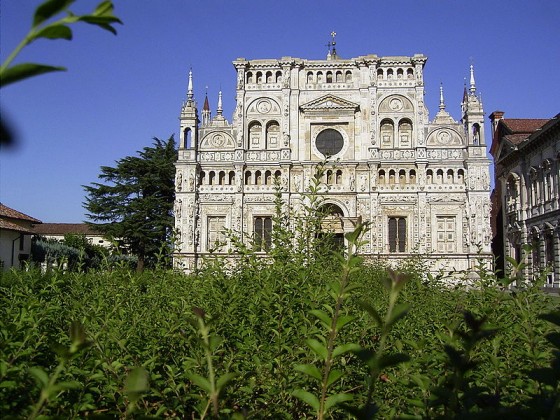
Pavia’s Carthusian monastery, an outstanding example of Gothic and Renaissance architecture, is still home to an order of Cistercian monks.
The Certosa di Pavia is situated a few kilometres north of the mediaeval university town of Pavia in northern Italy. It was commissioned by Gian Galeazzo Visconti, the first Duke of Milan, as a monastery and family mausoleum. The Duke had his court in Pavia and the Certosa (meaning ‘Charterhouse’ in English) was to be built in the Visconti family hunting grounds between Pavia and Milan.

Work commenced in 1396 but the buildings were not finally completed until the 16th century. The Certosa was originally home to an order of Carthusian monks, who remained there until they were expelled by the Austrian Emperor Joseph II in 1782. It was then variously occupied by other orders of monks, or closed, until the current Cistercian community arrived in the 1960s.
Architecture and design
The early Carthusians were known for their plain architectural design, but there is nothing plain about the Certosa di Pavia, which is famous for the extravagance of its Gothic and Renaissance architecture and for its collection of artworks.

The Certosa was intended to resemble the great Gothic Cathedral in Milan. However, it took around 200 years to build and, by the time it was completed, the new Renaissance ideals had taken hold in Italy. So although most of the complex, including much of the interior of the church, is Gothic, it was finished in the Renaissance style.
Visitors to the Certosa are greeted by the imposing Renaissance facade which is decorated with statues and carvings of saints and Roman emperors. Inside the church are many paintings and frescoes, as well as carved wooden choir stalls and an important collection of stained glass windows. The artworks date from the 15th to the 18th centuries, as the original inhabitants continued to add to the collection after the building was complete.
The back of the church leads to the Small Cloister, with its garden and arcades, and then on to the Grand Cloister where the monks’ cells open out onto the central garden.

A silent order
The Cistercians who now occupy the Certosa di Pavia are a silent order. They live in individual two storey cells around the Great Cloister. Each cell has its own small garden and a hatch by the door which allows food to be delivered to the monks without any need for communication.
The monks make their own herbal liqueurs, soaps and scents, which are on sale to visitors. The monk who serves in the shop may speak to customers, but only in a whisper.

Visiting the Certosa di Pavia
Certosa di Pavia has its own railway station, on the line from Milan to Pavia, and the monastery is a short walk from the station. Make sure that you get on the right train (some of them do not stop between Milan and Pavia) and that you sit in the middle, as the station platform is very short and it is not unknown for the train to move on before those at the end have got out.
The monastery is open every day except for Monday, from 9-11.30 and from 2.30-5.30 (it closes at 4.30 from October to March). Guided tours are given by a monk who is released from the vow of silence for this purpose: the tours are in Italian but it is worth joining to make sure that you do not miss any part of the complex. Entrance to the Certosa is free but donations for the tours are welcome.
